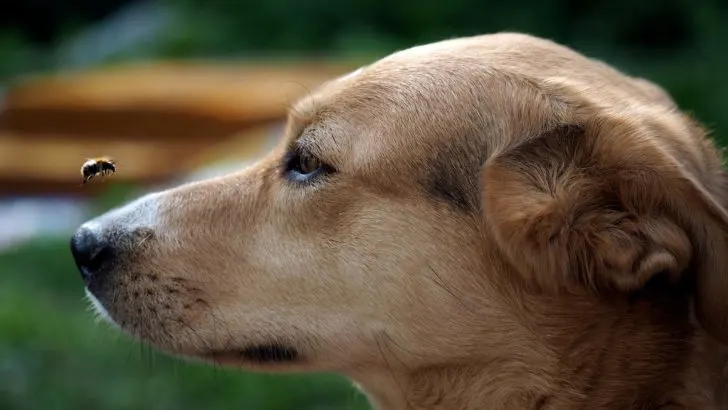When bees and dogs mix, it’s not always a sweet deal.
The moment you realize “Oh no, my dog ate a bee!” your heart might skip a beat.
It’s a scenario that pet parents dread, yet it’s surprisingly common given dogs’ curiosity and bees’ fearless defense system.
Bees are important pollinators and they are everywhere, especially during spring and summer.
So, there is a possibility of your dog eating a bee whenever he is romping through the garden, enjoying a sunny day in the park, or simply in the wrong place at the wrong time.
Encountering bees and other flying insects is almost an inevitable part of dog ownership.
This guide serves as your go-to resource for understanding the potential risks, immediate steps to take, and how to provide the best care for your canine companion after they’ve had a close encounter with a bee.
Don’t panic. Let’s tackle this issue together.
What Happens If A Dog Eats A Bee?
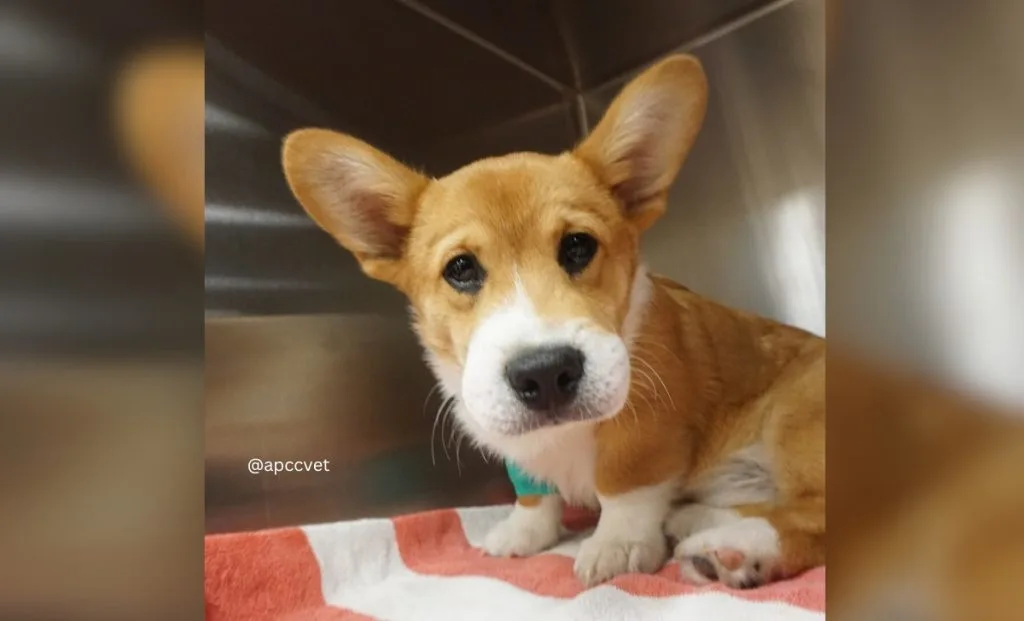
Eating a bee, whether it’s alive or has already met its end, doesn’t always spell trouble for our canine companions.
More often than not, a bee becomes nothing more than a good ol’ snack for them. It might just tickle their throat a bit on its way down. However, the scenario changes slightly if the bee decides to defend itself and deliver the sting as its final words.
The biggest challenge a bee or a wasp poses to your dog is triggering a severe allergic reaction, which can be fatal if not addressed on time. Unfortunately, there is also evidence of massive bee attacks resulting in the death of a German Shepherd.
If the bee manages to sting inside your dog’s mouth or throat, it can lead to swelling, redness, and noticeable discomfort.
This might also cause your dog to start pawing at their face, bite their paws, or cough. They may also show signs of confusion, irritation, or fear.
Most dogs will only experience mild discomfort or, at worst, vomit. However, the situation demands more attention if there’s severe swelling, especially if the sting site is the throat. This can complicate breathing.
Therefore, difficulty breathing, extensive swelling in the mouth or throat, or signs of a severe allergic reaction are clear indicators that your dog is facing an emergency situation.
These signs could mean that the bee sting has caused a bad reaction, requiring immediate medical attention.
7 Helpful Tips If Your Dog Ate A Bee
Here are some quick, helpful things that you can do if you think your dog just ate a bee.
1. Stay Calm And Observe
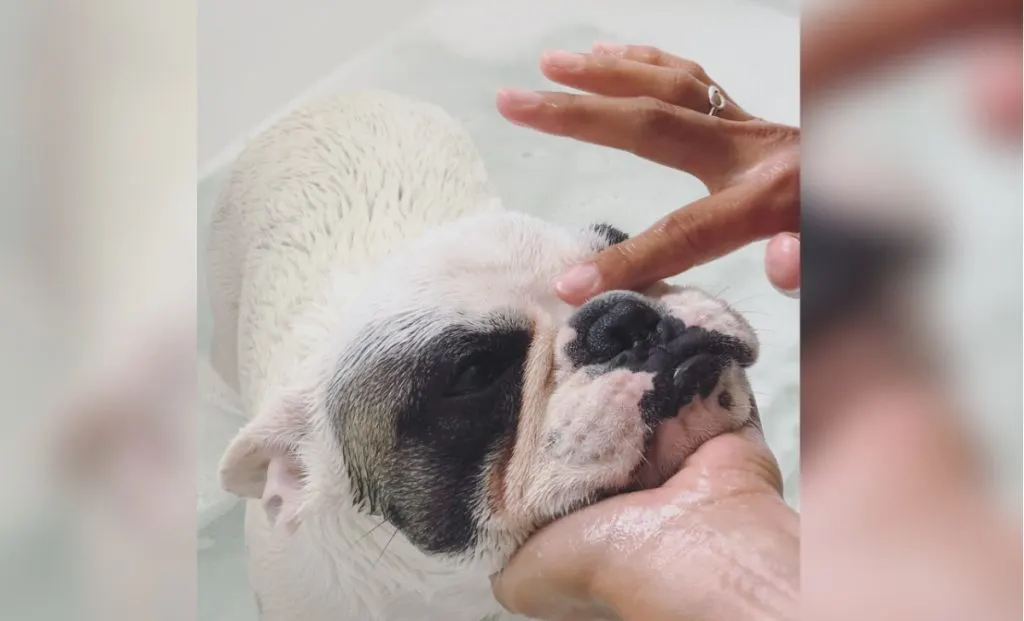
Your dog will look to you for cues on how to react. Make sure to take a deep breath and maintain composure.
Carefully observe your pup for any signs of discomfort.
This could manifest as excessive pawing at the face, unusual drooling, or signs of distress such as coughing, gagging, or even difficulty breathing.
Immediate action is crucial, and the best thing you can do at this point is observe. Then you will see if they exhibit difficulty breathing or severe reactions and make sure to prevent an emergency situation.
2. Check For Signs Of A Sting
If you are not sure whether your dog ate a bee or stepped on it, check for a sting.
Focus on areas like the mouth and tongue where swelling or a stinger may be present.
It’s important to approach this step cautiously, as your dog may be in pain and could react defensively!
3. Provide Water
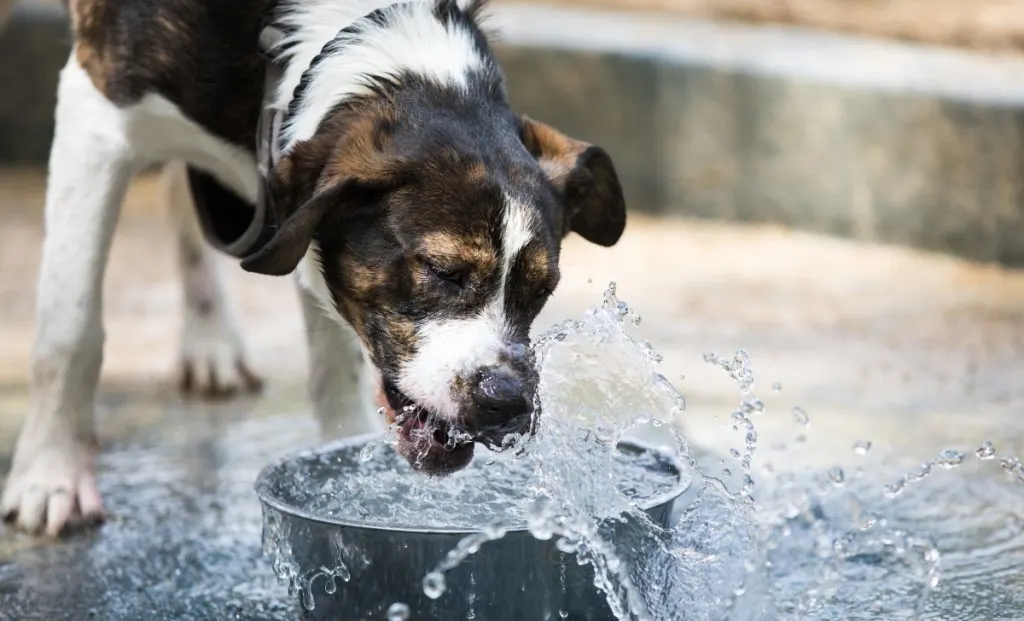
Keep a fresh bowl of water in the vicinity of your pup.
Water can help soothe any irritation in their throat from an internal sting. It may aid in helping them with their discomfort.
4. Offer A Cold Treat
Aside from water, a cold treat can be incredibly soothing for mild pain or swelling.
Opt for something soft and melting, like ice cubes or frozen broth cubes. Something that doesn’t require much chewing but provides relief and serves as a pleasant distraction.
5. Monitor For Allergic Reactions
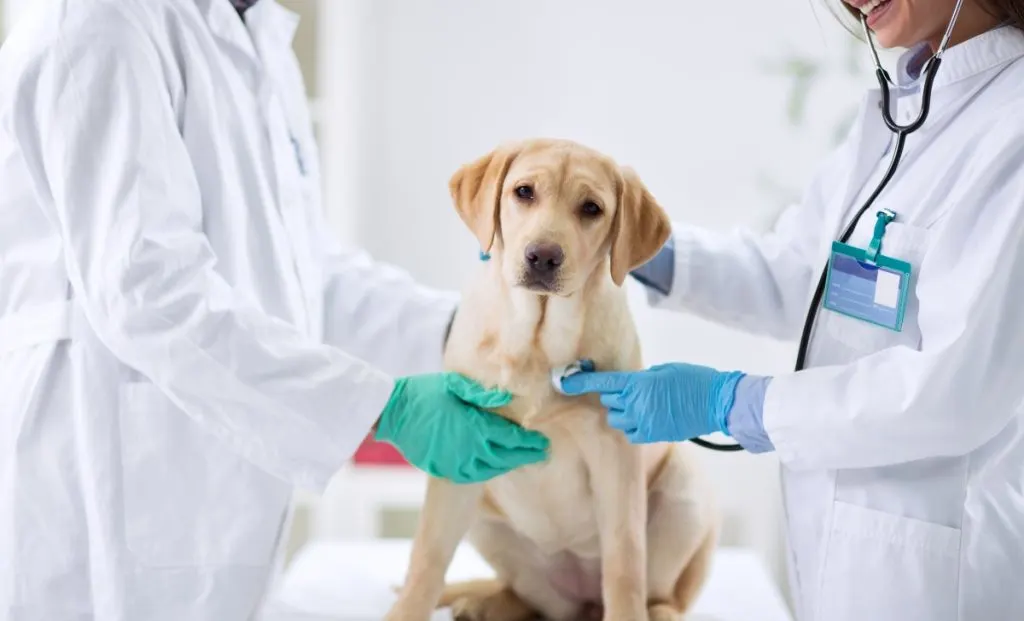
Be vigilant for any escalating symptoms such as extensive swelling around critical areas like the face or throat, skin reactions such as hives, or severe signs of distress including vomiting, diarrhea, or collapse.
Such symptoms of an allergic reaction indicate the need for immediate medical attention and veterinary care.
6. Contact Your Veterinarian
If you’re uncertain or if your dog shows any concerning symptoms, contacting your veterinarian should be your next step.
They will make sure your dog receives the best care. A vet will provide you with tailored advice and possible treatments against bee stings.
7. Administer Medication Only if Advised

If you are pondering over what to give your dog if they eat a bee, please take a moment and seek your vet’s advice.
You may be wondering if you can give a dog Benadryl for a bee sting, and the answer is yes, you can. You can usually give your dog 1 mg/lb tablet of Benadryl
Remember, administering human medications such as antihistamines should only be done under the guidance of your veterinarian.
Do not be shy to ask questions. Reputable vets will advise on the appropriate medication and dosage to avoid inadvertently harming your dog.
What If My Dog Ate A Bee But Didn’t Get Stung?
If your dog ate a bee but shows no signs of distress or symptoms of a bee sting, it’s likely the little critter didn’t get a chance to defend itself. Phew!
Maybe your dog just dreamt of that pesky bee!
In any case, this is a far more favorable situation compared to dealing with the complications of a sting.
However, even if there’s no immediate evidence of a sting area or signs of an allergic reaction, it’s still wise to keep a close eye on your furry pal for a few days.
Monitoring your dog closely is very important because, on the off chance the bee did manage to sting internal organs (like on the tongue, throat, or even stomach), symptoms of an allergic reaction could still show up.
If you’re concerned about the possibility of an internal sting or if you observe any symptoms that seem out of the ordinary, reaching out to your veterinarian is the best thing to do.
What To Do If A Dog Steps On A Bee?
Remember when Amber Heard mentioned her dog stepping on a bee? Well, while we can’t all have our pet mishaps make headlines, we can certainly make sure our dog gets the best care when they find themselves in such an unfortunate situation.
First things first, your dog stepping on a bee requires your calm and composed reaction. Dogs, much like us, can react dramatically to the sudden shock and pain of a bee sting.
Just like we put our hand away from something that suddenly stings, a dog jumps when they step on something weird, in this case, on a bee.
The most common areas for bee stings on dogs are indeed their paws, face, and mouth.
So, after your dog lunges out of surprise, keep a close eye for any signs of distress, swelling, or limping.
Remove The Bee Stinger
First, locate the sting site.
Removing the bee’s stinger as quickly as possible can help minimize the amount of venom injected into your dog’s paw.
Use a credit card or something similar to scrape over the affected area gently. You can also try scraping it off with your finger.
Tweezers might seem like the right tool, but they can actually squeeze more venom into the sting, so it’s best to leave them out of this operation.
Soothe And Neutralize The Sting
You may heard about DIY solution to stings and wonder ”Does vinegar help a bee sting on a dog?” Well, it does help a bit against wasp stings, due to them being alkaline. So, it does not help against bee venom, as it is acidic.
Instead, mix baking soda and water to create a paste, and apply it to the sting site to neutralize some of the bee venom’s effects.
This home remedy can provide mild relief and is a good first response while you put your best efforts to assess the situation further.
Us humans may use this handy mixture to help soothe irritation as well!
Use Ice To Reduce Inflammation And Swelling
An ice pack (or a pack of any frozen veggie) wrapped in a towel and applied to the swollen area can be a great way to reduce swelling and inflammation. Keeping it wrapped in a towel will avoid cold irritation to the skin, even if some coats of dogs are thick.
Keep it on the sting site for intervals of 10 minutes. This not only helps with swelling but can also be a distraction for your dog from the discomfort.
Contact Your Veterinarian For Advice
Even if your dog seems to be handling the situation well, it’s always a good idea to touch base with your veterinarian. Just to be on the safe side.
They can provide guidance on whether an antihistamine or other medication might be necessary to prevent a more severe allergic reaction. If needed, they may run some diagnostic tests, such as blood tests, to make sure to let you in on the possible treatments.
Remember, never play pharmacist – consult your vet before giving your pet any medication.
How Do I Know If My Dog Got Stung By A Bee?
Their symptoms ranged from difficulty breathing and jaundice to convulsions, showing the serious end of what bee venom can do.
If you’re wondering what it looks like having a not-so-sweet encounter with a bee, here are some signs your dog might exhibit:
- Restlessness
- Lethargy
- Heart rate increase
- Warm to the touch (fever)
- Mild swelling of affected area
- Puffy eyes
- Severe swelling of the general area
- Difficulty breathing
- Red eyes
- Swollen face, nose or neck
- Vomiting
- Coughing
- Excessive licking
- Pawing at face or other areas
- Nibbling near the affected area
- Excessive drooling
- Limping
- Being itchy
- Having inflamed skin on specific area
Effects of massive bee attacks on dogs can result in more extreme end of potential reactions.
The dogs involved in the study displayed symptoms ranging from apathy and congested mucous membranes to more severe conditions like hemoglobinuria (presence of hemoglobin in the urine), and even acute renal failure.
While rare, it is important to know the consequences of dogs being exposed to bees in such a situation involving multiple stings or a particularly sensitive individual.
From a behavioral point of view, dogs might lick their owners’ feet when they’re feeling nervous or in pain. It’s their way of seeking comfort or telling you something’s wrong.
Do Dogs Vomit After Eating A Bee?
Dogs might vomit after eating a bee, although it’s not a guaranteed reaction. The reasons behind such a response can vary.
For one, if the bee manages to sting the dog on its way down, the immediate irritation to the mouth or throat can occur. This can make the dog vomit, of course.
If a dog experiences an allergic reaction to the sting (delayed or immediate), this may also result in them vomiting.
The bee’s body itself, not just its sting, can be an irritant. Imagine swallowing something that’s not only foreign but comes equipped with its own defense mechanism. This could understandably upset your dog’s stomach.
Additionally, the physical discomfort from the sting, coupled with the possible stress or anxiety from the encounter, can make a dog feel sick enough to vomit.
So, a dog vomiting is a possibility depending on how their body reacts to the unexpected snack and its aftermath.
Make sure to take your pup to the veterinarian if you notice spontaneously vomiting or having trouble breathing.
How Long Does It Take For A Dog To React To Eating A Bee?
For most dogs, if there’s going to be a reaction to a bee or wasp sting, it typically becomes apparent within the first few minutes to an hour after the interaction.
This initial response window is when you’re most likely to observe the first signs of discomfort or distress, including pawing at the face, drooling, or even mild swelling at the sting site. The symptoms will vary depending on the affected area.
Not all reactions follow the same timeline or severity.
Some dogs have heightened sensitivity to bee venom. Some may experience severe allergic reactions. They both might show symptoms that are immediate and intense.
In these cases, signs like difficulty breathing, severe swelling, and even signs indicative of a systemic reaction such as sudden drops in blood pressure can occur.
While life-threatening reactions are unusual, they can happen.
The most vigilant pet owners will observe their dogs closely for up to 24 hours post-incident to catch any delayed reactions.
So, please stay alert and keep a close eye on your pup.
This period will allow you to monitor for both the immediate signs of discomfort and the more delayed, potentially serious signs of an allergic reaction.
Take Preventive Measures
As we wrap up our guide on what to do if your dog ate a bee, it is important to keep in mind that prevention is the best cure.
And no, creating a safe environment doesn’t mean stripping your garden of its beauty or keeping your dog from the joys of outdoor exploration.
It is more about staying alert during your leisurely walks, especially during spring and summer. You know, dogs are also attracted to the allure of blooming flowers where bees love to buzz!
A gentle tug on the leash or a timely call back can make all the difference in steering them away from potential danger.

Meet Iram, a devoted veterinarian, passionate dog lover, and current Ph.D. candidate at Utrecht University in the Netherlands. Seamlessly blending her roles as a vet and content writer, Iram channels her love for dogs into heartfelt narratives.
Since childhood, Iram nurtured a dream of becoming a vet, a passion that runs deep in her family. Having now fulfilled that dream, she’s eager to share her acquired knowledge. In her writing, Iram not only explores the emotional bond between humans and their canine friends but also integrates her veterinary expertise, offering readers a holistic understanding of their beloved pets.
